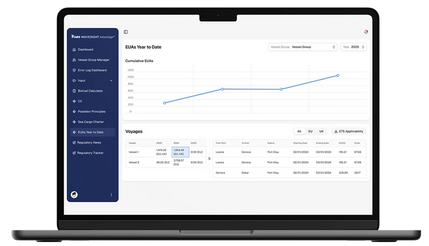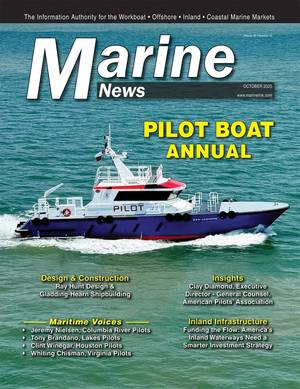Master Boat Builders: A Family Shipyard at Full Steam
Expansion into Harbor Tug sector helps Master Boat Builders nearly double in size, from 200 to 400 employees building eight to nine vessels per year, and the prospect of a new drydock plus additional partnerships and government construction contracts promises to power the company forward further, faster. Garrett Rice, President, Master Boat Builders, discussed the impetus for the company’s growth, and the growth in U.S. shipbuilding overall since the start of 2025 when President Trump made industrial revitalization and shipbuilding a priority.
When Garrett Rice walks through the gates of Master Boat Builders (MBB) each morning in Coden, Alabama, he’s not just clocking into work, he’s continuing a family legacy that began nearly half a century ago. Founded by his father in the late 1970s, the family-owned shipyard has grown from a small Gulf Coast operation a busy dynamic tugboat builders. Today, under Garrett’s leadership, MBB is on a trajectory of rapid expansion, doubling its workforce, ramping up production, and positioning itself to play a larger role in a resurgent U.S. shipbuilding industry.
Bayou Beginnings
“Coden, Alabama is as far south in Mobile County as you can get,” Rice said. “It’s a small bayou, but it’s home.” That humble setting belies the scale of what Master Boat Builders has achieved in recent years. The company has grown from about 200 employees two and a half years ago to roughly 400 today, operating across two facilities, its main yard in Coden and a wet dock facility in Theodore, Alabama, about 30 minutes north.
This growth hasn’t been accidental.
Rice attributes it to focus, diversification, and a sharpened sense of purpose. “For the longest time, we were a traditional workboat yard building supply boats, fishing vessels, offshore tugs,” he explains. “But in recent years, we’ve really honed in on the harbor and offshore tug market, which we see as sustainable for the long term.”
That focus has allowed the company to increase its output dramatically. “We’ve gone from building five or six tugs a year to eight or nine,” says Rice. “That’s a 35% increase in throughput, no small feat when you consider the man-hours it takes to build a tug.”
A Backlog Built for Momentum
MBB’s orderbook tells the story of that success. “We have 16 tugs under contract that we have yet to deliver,” Rice says. “We’ll deliver the next one in early November, and then a tug every six weeks through the end of 2027.”
Most of those vessels are Robert Allan Ltd.–designed harbor tugs, primarily in the RApport 2700, 2800 and 3000 series, serving major U.S. operators from coast to coast. The yard’s rhythm is steady and deliberate: start a tug every six weeks, deliver a tug every six weeks. “It’s the kind of consistent cadence that keeps our workforce engaged and our facilities running efficiently,” Rice notes. Image courtesy Master Boat Builders
Image courtesy Master Boat Builders
Delivering Power and Precision for Moran Towing
One of MBB’s highest-profile customers is Moran Towing Corporation, one of the nation’s oldest and most respected tug operators. “Moran is a great customer,” Rice says. “We’ve delivered three tugs so far in their six-vessel series, the William E. Moran being the first, and those boats went straight to work in New York Harbor.”
The tugs are the first for Moran designed by Robert Allan Ltd., and they measure 86 feet long (28 meters) and are powered by twin Caterpillar 3516E engines, producing nearly 7,000 total horsepower. With Kongsberg Z-drives and Markey bow winches, they achieve bollard pulls exceeding 80 tons, enabling them to handle ship-docking and escort duties with equal confidence.
“The next three Moran tugs are a bit different,” Rice adds. “They’re fitted with FiFi firefighting systems, larger 300-horsepower Markey winches, and enhanced Kongsberg drives for even better performance. You won’t see much difference from the outside, but under the skin, they’re beasts.”
Investing for the Future
For a yard that’s growing this fast, infrastructure investment is essential. “We’re taking delivery of a new dry dock this month from our friends at Conrad Shipyard,” Rice says. “It’s a big step for us because our channel here in Coden has only about eight feet of draft, while our tugs draw 18 feet.”
Previously, MBB relied on outside facilities, like Austal or Bollinger, to launch its vessels. Now, with its own dry dock, the company gains greater control over scheduling, logistics, and safety. “It’s a game-changer,” says Rice. “We’ll be able to launch and deliver on our own schedule, which makes us more efficient and predictable for our customers.”
Beyond the dry dock, MBB is also planning a new government-dedicated shipyard across the bayou in Coden. “We’ll talk more about it soon,” Rice hints, “but it’s part of our effort to support the Navy and Coast Guard through partnerships and outsourcing agreements.”
Those partnerships include a significant new collaboration with Austal USA, headquartered just 30 minutes north in Mobile. “We’re working with Austal on a strategic outsourcing agreement,” Rice explains. “They build big ships and do it well. We can help increase their throughput and de-risk some of their backlog by handling specific modules or vessel components.”
It’s a symbiotic relationship, he says, one that will also benefit the broader regional workforce. “We’re talking about joint workforce development initiatives. The more work we keep here in the Mobile area, the stronger our entire industrial base becomes.”
Modernizing Processes: One Tug at a Time
Even as MBB remains steeped in hands-on craftsmanship, Rice is pushing the yard toward greater digital integration. “Tugs are tough for automation—they’re small, there aren’t a lot of big panels for robotic welding—but we’re testing some robotic processes over the next six months,” he says.
The bigger leap has been in design and engineering. “Everything we do now is 3D modeled,” Rice explains. “Our engineering efforts have grown tremendously, which is creating real efficiencies in production. We’ve moved from an old-school, mom-and-pop approach to a modern shipbuilding operation, while keeping the family culture intact.”
That combination, family-driven values and modern methods, has become Master Boat Builders’ signature. The yard’s reputation for quality, reliability, and partnership has made it a go-to builder for operators like Crowley, G&H Towing, Kirby, Seacor Marine, and now Moran. “We’re a small part of a big industry,” Rice says, “but we’re proud of the part we play.”
The Reawakening of U.S. Shipbuilding
Rice is candid about what he sees happening across the American shipbuilding landscape and why it matters.
“This is the most exciting time I’ve seen in my lifetime for U.S. shipbuilding,” he says. “The momentum started a couple of years ago, but it’s really taken off following the President’s executive order and congressional action to revitalize the shipbuilding base.”
He cites legislation like the SHIPS Act, White House initiatives, and the creation of a National Office of Shipbuilding and ultimately contracts being signed as “demand signals” that are finally prompting investment. “For years, people said the U.S. industry couldn’t do it—that we didn’t have the capacity,” Rice recalls. “Our response has always been: give us a clear demand signal, and we’ll respond.”
The “One Big Beautiful Bill,” has set the stage for that response. “The money is appropriated; the signal is clear,” he says. “Now it’s up to the industry to step up, invest, and deliver.”
For smaller and mid-tier yards like MBB, he believes the key lies in strategic partnerships and modular construction. “We don’t all have to build entire ships,” Rice explains. “There’s room for a tiered ecosystem—where smaller yards handle modules or specialized components for larger builders. It’s a smarter, lower-risk way to expand capacity.”
That’s part of why MBB’s partnership with Austal USA is so significant: it’s a practical example of how collaboration can strengthen the entire industrial base. “We can’t get to a 355-ship Navy or support a growing commercial fleet by relying on just five or six big yards,” Rice says. “We have to think broader.”
He’s optimistic that this new era of cooperation and investment will bear fruit. “For the first time in a long time,” Rice says, “there’s real energy, real opportunity, and real belief in the future of American shipbuilding. And Master Boat Builders intends to be right in the middle of it.”
- Master Boat Builders Key Statistics
Founded: Late 1970s (family owned)
Employees:~400 (up from 200 in 2022)
Facilities: Coden, AL (main yard) & Theodore, AL (wet dock)
Annual Output: 8–9 tugs per year
Backlog: 16 tugs under contract, deliveries every 6 weeks through 2027
Key Designs: Robert Allan Ltd. RApport series (2700/2800/3000)
Major Investments:- New dry dock from Conrad Shipyard
- New government-focused facility planned in Coden
- Experimentation with robotic welding
Watch the interview with Garrett Rice on Maritime Reporter TV:














